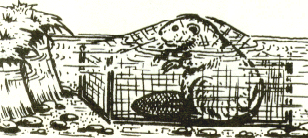
SUMMER 1995
Wildlife can sometimes be a nuisance to people, especially if the wildlife is damaging property. Some people trap the wildlife themselves, but need the tools to do the job. A Nova Scotia man has designed a trap specifically for water animals, such as beaver and otters, but it can be easily adapted for other wildlife species.
Harry Mowatt has had contact with wildlife for many years, from a young boy hunting, fishing, and trapping, to 27 years working for the Department of Lands and Forestry, and now as a private nuisance wildlife operator. Harry has trapped just about every animal in Nova Scotia, including bobcats, black bears, beavers, skunks, foxes, fisher, rabbits, and coyotes. He has used most existing live traps over the years, but decided to design and build his own live trap.
"I've never cared much for any of them or their success rate," he says. "That is why I decided to design a trap that would catch water and land animals unharmed."
He started designing his trap in 1977 and it was finished in the late 1980s. It is built in his backyard in Truro, N.S.
"It was designed to catch beaver and otter alive and humanely, but has also shown success with muskrats, raccoons, skunks, foxes, small dogs, house cats, hens, ducks, pheasants, and grouse," he says.
For an even higher success rate with water animals, this trap can be set under water with about 2.5 to 5 cm of water over the top so the animals don't see or smell it. When caught, they can stand on the bottom and push up the top mesh to get air. Built from galvanized wire mesh, the trap is designed to last for many years. Animal limbs are safe from entrapment because of the unique door design. Depending on the animal requirements, this trap can be built with various dimensions, wire gauge sizes, and number of doors.
